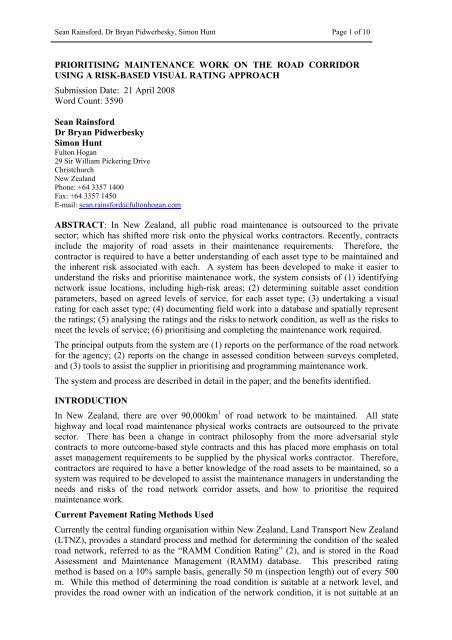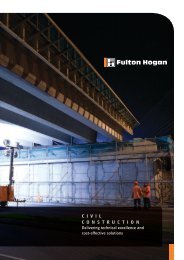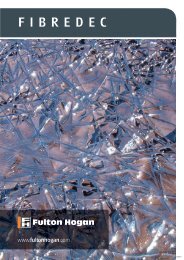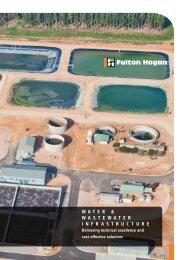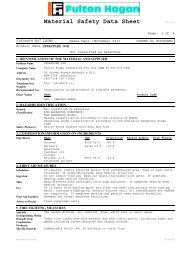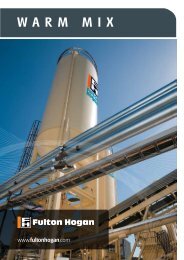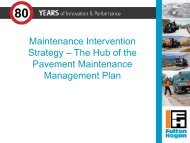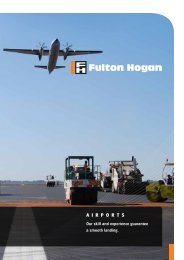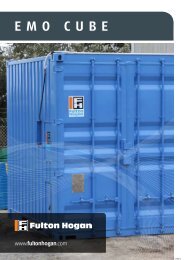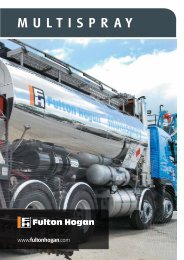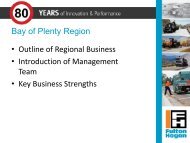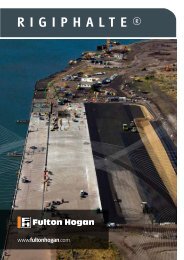PRIORITISING MAINTENANCE WORK ON THE ... - Fulton Hogan
PRIORITISING MAINTENANCE WORK ON THE ... - Fulton Hogan
PRIORITISING MAINTENANCE WORK ON THE ... - Fulton Hogan
Create successful ePaper yourself
Turn your PDF publications into a flip-book with our unique Google optimized e-Paper software.
Sean Rainsford, Dr Bryan Pidwerbesky, Simon Hunt Page 1 of 10<strong>PRIORITISING</strong> <strong>MAINTENANCE</strong> <strong>WORK</strong> <strong>ON</strong> <strong>THE</strong> ROAD CORRIDORUSING A RISK-BASED VISUAL RATING APPROACHSubmission Date: 21 April 2008Word Count: 3590Sean RainsfordDr Bryan PidwerbeskySimon Hunt<strong>Fulton</strong> <strong>Hogan</strong>29 Sir William Pickering DriveChristchurchNew ZealandPhone: +64 3357 1400Fax: +64 3357 1450E-mail: sean.rainsford@fultonhogan.comABSTRACT: In New Zealand, all public road maintenance is outsourced to the privatesector; which has shifted more risk onto the physical works contractors. Recently, contractsinclude the majority of road assets in their maintenance requirements. Therefore, thecontractor is required to have a better understanding of each asset type to be maintained andthe inherent risk associated with each. A system has been developed to make it easier tounderstand the risks and prioritise maintenance work, the system consists of (1) identifyingnetwork issue locations, including high-risk areas; (2) determining suitable asset conditionparameters, based on agreed levels of service, for each asset type; (3) undertaking a visualrating for each asset type; (4) documenting field work into a database and spatially representthe ratings; (5) analysing the ratings and the risks to network condition, as well as the risks tomeet the levels of service; (6) prioritising and completing the maintenance work required.The principal outputs from the system are (1) reports on the performance of the road networkfor the agency; (2) reports on the change in assessed condition between surveys completed,and (3) tools to assist the supplier in prioritising and programming maintenance work.The system and process are described in detail in the paper, and the benefits identified.INTRODUCTI<strong>ON</strong>In New Zealand, there are over 90,000km 1 of road network to be maintained. All statehighway and local road maintenance physical works contracts are outsourced to the privatesector. There has been a change in contract philosophy from the more adversarial stylecontracts to more outcome-based style contracts and this has placed more emphasis on totalasset management requirements to be supplied by the physical works contractor. Therefore,contractors are required to have a better knowledge of the road assets to be maintained, so asystem was required to be developed to assist the maintenance managers in understanding theneeds and risks of the road network corridor assets, and how to prioritise the requiredmaintenance work.Current Pavement Rating Methods UsedCurrently the central funding organisation within New Zealand, Land Transport New Zealand(LTNZ), provides a standard process and method for determining the condition of the sealedroad network, referred to as the “RAMM Condition Rating” (2), and is stored in the RoadAssessment and Maintenance Management (RAMM) database. This prescribed ratingmethod is based on a 10% sample basis, generally 50 m (inspection length) out of every 500m. While this method of determining the road condition is suitable at a network level, andprovides the road owner with an indication of the network condition, it is not suitable at an
Sean Rainsford, Dr Bryan Pidwerbesky, Simon Hunt Page 2 of 10operational level to assist the maintenance manager in easily understanding the requirementsand locations of issues on the road network.One of the other concerns with the current visual rating method is that the pavement anddrainage functional condition parameters are the only asset features assessed, whereas thecontractor has to manage all assets within the road corridor. The current visual ratingparameters prescribed to be assessed are in Table 1 and 2.TABLE 1 – Pavement Condition Rating Faults Recorded within New Zealand as perRAMM Condition Rating requirementsCarriageway Description Inspection LengthRutting Length of wheel path with rut depth > 30mm Inspection LengthShoving Length of wheel path exhibiting shoving (m) Inspection LengthScabbingArea of carriageway seal that has lost > 10% sealing Inspection Lengthchip. For asphaltic surfaces, area of ravelling (m 2 )Flushing Length of wheel path flushed (m) Inspection LengthAlligator Cracks Length of wheel path exhibiting alligator (fatigue) Inspection Lengthcracking (m)Longitudinal & Length of wheel path exhibiting longitudinal and Inspection LengthTransverse Cracks transverse cracking (m)Joint Cracks Length of wheel path with joint cracking (m) Inspection LengthPotholes Number of potholes Inspection LengthPothole Patches Number of pothole patches Inspection LengthEdge Break Length of carriageway edge showing signs of edge Inspection Lengthbreak where there is no surface channel (m)Edge Break Patches As for edge break except that the edge break has been Inspection LengthHigh/Low ServiceTrench Covers. HighLow Patches andTrenchespatched (m)Number of service covers and trenches in the wheelpath that are > or < the level of the carriageway by20mm or moreInspection LengthTables 1 and 2 show the faults identified in the standard current rating method in NewZealand; other assets within the road corridor are not assessed. The amount of time requiredto undertake a survey can be extensive depending on the length of the given road network,because each fault has to be physically measured and recorded (2). The requirement tomeasure each fault in detail within the 10% sample length (inspection length) means that thecurrent method of evaluating the condition of the road pavement and drainage is at a microlevel of detail for a macro level of network.This method does not identify risks to the contractor on the given road section. With theincreased financial risk placed on the maintenance contractor, an alternative method wasrequired to be developed that would include the assessed risks, and provide a fast, effectiveand efficient way of assessing the network asset conditions; this alternative method, RoadCorridor Assessment and Maintenance Evaluation System (RCAMES), is described in thenext section.
Sean Rainsford, Dr Bryan Pidwerbesky, Simon Hunt Page 3 of 10TABLE 2 – Drainage Condition Rating Faults Recorded within New Zealand as perRAMM Condition Rating requirementsSurfaced Channels Description Full LengthLeft Hand Side (LHS) Length of surfaced SWC that is ineffective because it Full LengthSurfaced Surface Water is broken (m)Channel (SWC) – BrokenLHS Surfaced SWC with Length of surfaced SWC that is ineffective because it Full LengthHigh Lip of ChannelLHS Surfaced SWC withBroken Surface at ChannelLipSurfaced SWC – BlockedSurfaced SWC with Gradeof Channel IncorrectEarthen Surfaced WaterChannelsEarth SWC - BlockedEarth SWC – InadequateIneffective Shoulderhas a high lip channelLength of surfaced SWC that is ineffective due tobreak in the carriageway surfacing along thepavement/channel boundaryLength of surfaced SWC that is ineffective becausethe channel is blockedLength of surfaced SWC that is ineffective becausethe grade of the channel is uphill to the catchpitDescriptionLength of earth SWC blocked by vegetation and/orsoil such that water ponds and the SWC is not able toeffectively channel water away from the pavement toa cut-out or culvertLength of earth SWC below the standard set by theroad controlling authority. May also be a length wherean SWC is required but does not existLength of shoulder that will not allow the free flow ofwater from the road surface to the SWCFull LengthFull LengthFull LengthFull LengthFull LengthFull LengthFull LengthROAD CORRIDOR ASSESSMENT AND <strong>MAINTENANCE</strong> EVALUATI<strong>ON</strong> SYSTEMThe RCAMES procedure for assessing the road network corridor requirements consists of:1. Agreeing with the road agency on the Assets to be maintained within the current contract2. Determining the risks/issues for the maintained road network3. Determining the required level of service to be maintained for each asset type4. Performing field inspections and assess the network5. Documenting field inspections in a database6. Reporting on findings, prepare and prioritise work for programme7. Completing work based on best practice and experienceThe system’s key components and their relationships are illustrated in Figure 1. The processwill be repeated and improved throughout the contract period. This method is alsoincorporated into the self-auditing process that is a contractual requirement within thephysical works maintenance contracts within New Zealand (3).
Sean Rainsford, Dr Bryan Pidwerbesky, Simon Hunt Page 4 of 10FIGURE 1 – Road Corridor Assessment and Maintenance Evaluation SystemDetermine Assets to be Maintained and AssessedPart one of the process is to agree with the Client the actual assets to be maintained on thegiven road network. This will generally be specified within the contract documents, with thecontract documents forming the initial part of the discussions. The main purpose of thisdiscussion is to determine the time and extent of getting the surveys completed for each assettype. With the extent of some of the road networks, the logistics of surveying the entirenetwork can be difficult. Therefore, careful consideration of resource levels and inputsrequired is important before undertaking any survey on the road network. The output fromthe initial discussion is a complete asset list, including quantities, expected survey timing andanticipated duration of each survey. Once the surveys have been initiated, this list can bereviewed and revised to better reflect the actual times required for each asset type. Thisdocument will become the governing basis for the remainder of the contract period, andprovides for the continual staff turnover that is bound to take place during any longer termstyle maintenance contract.Risk/Issues AssessmentThe next step is to determine the risk/issues on the given road network. A workshop is heldwith the Client to determine what the perceived risks are to the road network. No detail isconsidered in the initial discussions, as the purpose is to determine the generic risks/issuesthat will affect the maintenance contractor from performing successfully. The risks/issuesdetermined are related to the maintenance of the road corridor, and are generallyenvironmentally focused. Issues such as inflation, price increases, and resource issues are notcovered as part of this process. Once the risks and issues are identified, a network survey isrequired. This is completed by undertaking a road survey with an experienced maintenancesupervisor. For each road section, as defined by the road controlling authority (usuallycarriageway sections), the risk is evaluated based on the experience of the contract manager.The assessed risk is given a level of consequence/occurrence based on a simple High,Medium or Low qualitative method. Figure 2 provides an example of the risk surveycompleted for a road network.
Sean Rainsford, Dr Bryan Pidwerbesky, Simon Hunt Page 5 of 10FIGURE 2 - Risk / Issue Assessment ExampleThis risk assessment is not developed to be a detailed level risk assessment; its purpose is toassist the maintenance contractor in understanding the network, and align the maintenancework to mitigate any potential issue that may arise at the given location. The evaluatedrisks/issues will be used in a risk matrix to assist the maintenance contractor in understandingthe likelihood of success for certain failure mechanisms. This will then be used to determinea maintenance priority for the road section. The next stage is to perform the conditionassessment of the road network.Asset Condition AssessmentTo assess the road condition, an experienced maintenance supervisor and contract manager dothe survey. Prior to commencing the survey, specific details are agreed with the road agencywith regard to: Road network section lengths Inspection timing Condition Fault ParametersThe survey is completed using a Global Positioning System (GPS) receiver and tablet, asshown in Figure 3, which records each fault, assessed level and location. Utilising the GPSco-ordinates as location positions allows the road sectioning to be defined and altered ifrequired on the road network. For each road section, the worst assessed score will beassigned to the road length, thereby ensuring the network is reported as a worst case scenario,and ensures the priorities will be taking place at the appropriate locations. Table 3 providesdetails of the guidance provided to the maintenance managers and road controlling authorityon the recommended sectioning to get realistic results for the road network. The sectioning isfixed in length due to the outcomes from the process assisting the contract manager inlocating the work to take place. Any change in section locations will affect monitoring of thecondition distribution over time.The timing for the assessments is dependent on the requirements of the road agency and thecontract specification. The road corridor assessment is performed at the start of the contractand at 6-monthly intervals thereafter. Certain benchmark or strategic roads can be identifiedfor more frequent surveys; this can be discussed and agreed with the road agency. At aminimum the entire network is surveyed annually, thus allowing for monitoring andmeasurement of the current maintenance intervention strategy for the road assets.
Sean Rainsford, Dr Bryan Pidwerbesky, Simon Hunt Page 6 of 10TABLE 3 - Inspection lengths (m) per road type and road surfaceSpeed Road Inspection length according road surfaceEnvironment Hierarchy Sealed / Surface Dressing Unsealed / GravelLocalFull length if < than 200mFull Lengthlong; otherwise 100mUrban Collector 50 m Full LengthArterial 50 m Full LengthStrategic 50 m Full LengthLocal 500 m 2,000 mRuralCollector 500 m 1,000 mArterial 200 m 500 mStrategic 100 m 500 mBased upon the initial discussions with the road agency, the list of assets to maintain isdetermined. Table 4 contains an example of a list of asset types that are assessed in currentcontracts; these asset types have condition parameters assigned to each. The conditionparameters are aligned to the level of service that is required to be achieved within themaintenance contract. A workshop is held with the road agency to determine the level ofservice, and the condition parameter listings reflect the outcomes from these discussions.TABLE 4 – RCAMES Asset Type and Condition ParametersAsset TypeSealed RoadsUnsealed RoadsRural DrainageUrban DrainageFootpathVegetationSignageGuardrailStreetlightCondition ParametersRoughness, Rutting, Cracking, Potholes, Delamination/Scabbing, Edge Break,Flushing, Failed PatchesRoughness, Corrugations, Crossfall / Road Shape, Loose Gravel / Windrow,Potholes, Shoulder / ScouringWatertable Level, Drainage Structure, Ponding, Shoulder Width, Scouring,Shoulder Vegetation and Crossfall, Horizontal DrillingKerb and Channel Condition, Gully / Channel Condition, PondingFootpath ConditionVegetation Visual AssessmentSignage Visual AssessmentGuardrail Visual AssessmentStreetlight Visual AssessmentA simple assessment / scoring method, which is detailed in Table 5, has been used to rate theassets on the given network.TABLE 5 - RCAMES Rating Assessment ScoresRatingAssessmentScoreCondition Contract Requirements Action1 Fair Approaching Contract Requirement Annual / 6 Month Programme2 Indicative On or just above contract Requirement 3 – 6 Month Programme3 Poor Above Requirements 1 – 3 Month Programme4 Failed Major Issue Fix Immediately
Sean Rainsford, Dr Bryan Pidwerbesky, Simon Hunt Page 7 of 10The scoring system is aligned to the contract level of service requirements, which ensures thatthe contract manager is working within the Client’s expectations. For each of the conditionparameters listed, the score is assessed for the road network. Table 6 contains an example ofhow the scoring works for the sealed road pavement.TABLE 6 - Sealed Road Pavement RCAMES Assessment ScoresRating 1 2 3 4Condition Fair Indicative Poor FailedContractRequirementsRoughnessRuttingCrackingPotholesDelamination/ScabbingEdge BreakFlushingFailedExistingPatchesApproaching Contract Requirement Above Requirements Major IssueSlightly roughrideEvidence ofrutting, flushingNoninterconnectedsingle cracks1 or 2 minorpotholes due tojoin/seam(20mBlowout, PatchdestroyedField InspectionsWhen the assessors are surveying the road network, the assessed score for the conditionparameter is selected at the location the fault is found. The assessment can be completed atvarious speeds depending on the experience and capability of the assessors used. Consideringthe safety of the operators and logistical requirements it has been found that the distancetravelled in a single day should be no greater than 400 km. The time and date is capturedwith the condition parameter and score as the assessor selects the option on the tablet asshown in Figure 3. The survey records will be processed with the GPS information todetermine the actual coordinates for the fault, based on the time-stamp matching process.The user will select the relevant asset type at the start of the survey and then the variouscondition parameters will appear on the screen relevant to that asset type.
Sean Rainsford, Dr Bryan Pidwerbesky, Simon Hunt Page 8 of 10FIGURE 3 - RCAMES Survey Touch Screen ExampleRisk ScoringWhen the survey is completed and loaded into the specified database, the final stage indetermining the overall assessed score for the road section is based on the risk matrixdescribed earlier. For each condition parameter, the likelihood, occurrence and consequencehave been determined based on a simple qualitative risk assessment method. For each part ofthe matrix, a multiplier is used in affecting the actual score assessed during the RCAMESsurvey. This multiplier weights the assessed score to allow for the risk exposure to themaintenance contractor. An example of the risk matrix is contained in Table 7.The multipliers used for determining the score for the road sections are: HIGH risk section = 2 MEDIUM section = 1.5 LOW risk section = 1For example, if the road section has an assessed condition score of 3, and is within a HIGHrisk section, then the score assigned to the road section will be 3 x 2 = 6From the final score determined, we can see that this road section will have a higher prioritythan a road section with a score of 4 (worst score). This is an important aspect of the scoringmethod used as the risk associated with the road section has resulted in the road sectionrequiring immediate attention and will be programmed for work.REPORTINGThe reporting of the results for the RCAMES survey is generated for various levels ofmanagement. The network owners, from the Road Controlling Authority require informationat a network and sub network level to understand the overall condition of the assets assessed,and to determine the trends of condition over time so the maintenance strategy can be alignedaccordingly. The contract manager and operational staff require information at the road androad section level to address the assessed faults and ensure action is undertaken at the specificlocations.
Sean Rainsford, Dr Bryan Pidwerbesky, Simon Hunt Page 9 of 10TABLE 7 - Qualitative RCAMES Risk MatrixCondition ParameterEnvironmentalFactorRoughnessRuttingCrackingFlushingDelamination/ ScabbingFlooding High Medium Medium Low LowPonding Low High Medium High MediumSlip Prone High Medium High Low LowRock Fall Medium Low Low Low MediumShade Low Low Medium High HighLeaf Prone Low Low Medium Medium HighThe score for the road section is determined by adding the individual scores of all thecondition parameters, and applying the risk weighting applicable to the condition parameter.The overall scores are then grouped into 5 bands (excellent, good, fair, poor and very poor) asshown in Figure 4. The percentage of the road length surveyed in each band is monitoredover time at a network level. This analysis can also be created at sub-network and road levelto assist the road authority in determining the asset condition at a more detailed level ifrequired. The results for each survey are also put onto maps, including the risk factors, andprovided to the contract managers to locate the priority locations for maintenance activities.Figures 4 and 5 contain some examples of the standard outputs generated from the RCAMESsurvey results.40%35%30%25%20%15%10%5%0%Excellent Good Fair Poor Very PoorAugust 2006 February 2007 August 2007FIGURE 4 - RCAMES Survey Results by Network
Sean Rainsford, Dr Bryan Pidwerbesky, Simon Hunt Page 10 of 10FIGURE 5 - RCAMES Mapped Survey ResultsC<strong>ON</strong>CLUSI<strong>ON</strong>SThrough the rigorous process of determining the levels of service criteria and conditionparameters in collaboration with the maintenance contractor, it allows for the contractor toprioritise and use resources more efficiently on the road network. The purpose of theRCAMES survey is to identify and prioritise maintenance work locations; it will notdetermine the actual treatment required for the condition fault. Treatment selection, based onlocal practices and experience, will take place as per normal contract arrangements. With theincorporation of risk into the decision process, the location and work priorities are targeted toprovide best for road.The benefits of using such an assessment method accrue at all levels of the physical workscontract, and include: Alignment of the maintenance strategy to achieve the desired level of service for theroad owner Prioritisation and location of maintenance work for the contractor Incorporation of risk factors into the decision process to ensure the maintenance workwill achieve the desired result Justify granting of funding requests Assists the road network owner and contractor in understanding and managing thenetwork efficiently while maintaining the asset to the agreed level of serviceREFERENCES:(1) Land Transport New Zealand. Network Statistics 2006/07http://www.landtransport.govt.nz/about/docs/network-stats-2006-07.pdf . Accessed 21 April2008.(2) New Zealand Institute of Highway Technology Ltd.. RAMM Condition Rating – SealedRoads. Part 2 Rating Guide, New Plymouth, 2007, pp 15 – 26.(3) Transit New Zealand. State Highway Maintenance Contract Proforma Manual – SM032,Issue 6, March 2007, Wellington, New Zealand.


